|
Space tourism
The extreme of tourism
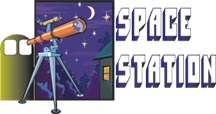 Just
think for a moment how you love going sightseeing in various places of
our beautiful country. The sight of picturesque waterfalls, the big blue
sea and the view from the top of a mountain might have really fascinated
you. Some of you may have even visited some nice places in other
countries as well. Just
think for a moment how you love going sightseeing in various places of
our beautiful country. The sight of picturesque waterfalls, the big blue
sea and the view from the top of a mountain might have really fascinated
you. Some of you may have even visited some nice places in other
countries as well.
Man is usually never satisfied, and a new trend has begun where
traveling, not only all over the globe, but also out of it in to space,
is explored. This new interest, where certain people go out into space
just for pleasure, is known as space tourism.
When we go back in time, we will notice that whoever left our dear
planet Earth to go into space were well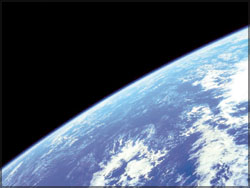 educated and specially trained astronauts; they went up there to do some
serious work. But, today, outer space too has become a tourist
attraction.
educated and specially trained astronauts; they went up there to do some
serious work. But, today, outer space too has become a tourist
attraction.
The only reason why you and I cannot try this out is because the
ticket is going to cost a lot of money. Russia provides facilities for
space travel, and you may be surprised to learn that visits to outer
space are already booked until 2009, although the ticket costs over $20
million dollars.
Imagine that! The reason these people spend such a lot of money to go
into outer space is primarily the amazing view of the Earth which they
get to see with their own eyes. Apart from that, the thrill they
experience during lift-off and the true zero gravity effect are other
attractions.
Although this has become a hot topic nowadays, there have been visits
to space made by those other than qualified cosmonauts.
There's a belief among the Western countries that Valentina
Thereshkova, the first woman to go out in to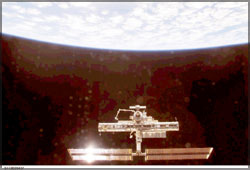 space, was less qualified than other astronauts, and therefore she too
was like a tourist.
space, was less qualified than other astronauts, and therefore she too
was like a tourist.
Apart from that, NASA has given the opportunity for two of their
sponsors, namely Senator Jake Garn and Bill Nelson to travel on a space
shuttle. Again in 1990, Russia agreed to carry a Japanese reporter from
a television company to the Mir space station for a payment of 28
million US dollars.
The concept of travelling into space for pleasure started in 2001
when Dennis Tito paid and visited the International Space Station(ISS)
and spent seven days over there. In 2002, the second space tourist, Mark
Shuttleworth, a South African millionaire and in October 2005 the third
space tourist, Gregory Olsen visited the ISS.
A few others who wished to take part in space tours had to stay back
due to health reasons, But Anousheh Ansari succeeded in becoming the
fourth space traveller. The fifth is about to take off very soon.
He is a Hungarian-born American software developer and billionaire
called Charles Simonyi and he will take off on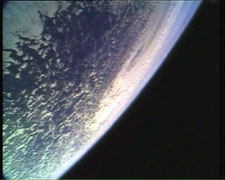 April 7. Even though at the moment you may not be able to afford it,
someday you may get the opportunity to be a tourist to space, enjoy the
magnificent view from up there and get the experience of a lifetime.
April 7. Even though at the moment you may not be able to afford it,
someday you may get the opportunity to be a tourist to space, enjoy the
magnificent view from up there and get the experience of a lifetime.
***
Brazil and Ukraine form a space
company
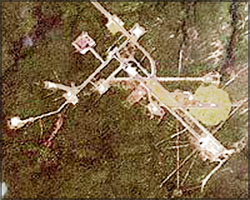 Russia
and USA have been the giants in space travel until quite recently. But,
many other countries have started space travel during the past few
years. Likewise, Brazil and Ukraine have established a company for
rockets and satellites. Russia
and USA have been the giants in space travel until quite recently. But,
many other countries have started space travel during the past few
years. Likewise, Brazil and Ukraine have established a company for
rockets and satellites.
The first launch is planned for 2009. Brazil will make available its
launch area in Alcantara and the Ukrainians will provide the launching
technology developed in Ukraine.
***
India looks at sending astronauts
into space
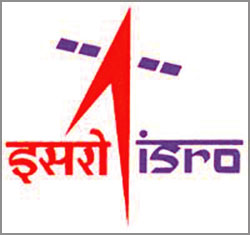 India,
who is another new entrant into space exploration considers sending a
man into space after their Moon exploration mission. India's first Moon
exploration mission, which is known as Chandrayaan-1 is expected to be
launched early next year. India,
who is another new entrant into space exploration considers sending a
man into space after their Moon exploration mission. India's first Moon
exploration mission, which is known as Chandrayaan-1 is expected to be
launched early next year.
The Indian Space Research Organisation (ISRO) is considering sending
men to the Moon depending on the results they get from the Chandrayaan-1
mission. However, their first step is to send a man into orbit and bring
him safely back to Earth as a test.
****
Spacecraft to turn away asteroids
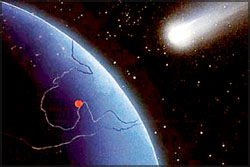 Can
you remember how asteroids are destroyed by shooting rockets at them in
movies? But in reality, this seems a bit risky. US space scientists are
hoping to use small spacecraft to draw the asteroids away from Earth, by
using the gravitational pull between the spacecraft and the asteroid. Can
you remember how asteroids are destroyed by shooting rockets at them in
movies? But in reality, this seems a bit risky. US space scientists are
hoping to use small spacecraft to draw the asteroids away from Earth, by
using the gravitational pull between the spacecraft and the asteroid.
US scientists are closely monitoring the behaviour of Apophis, which
is expected to pass about 32,000 kilometres close to the Earth in 2029,
and would most probably be on a collision course in 2036! It is planned
to draw this asteroid away by using this new discovery.
Aravinda Dassanayake |
